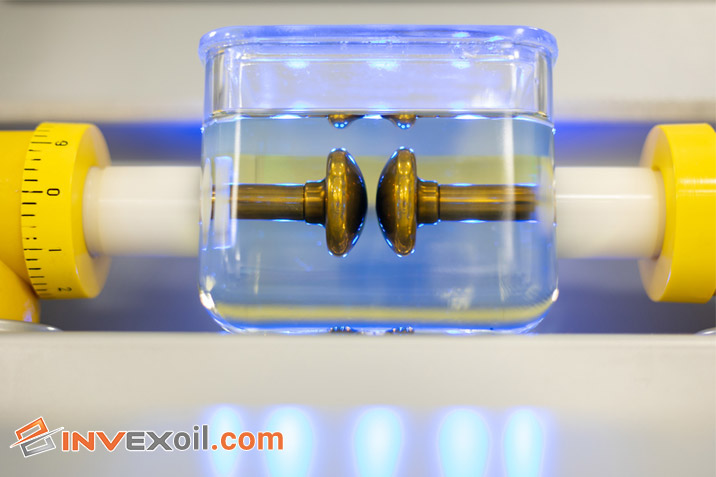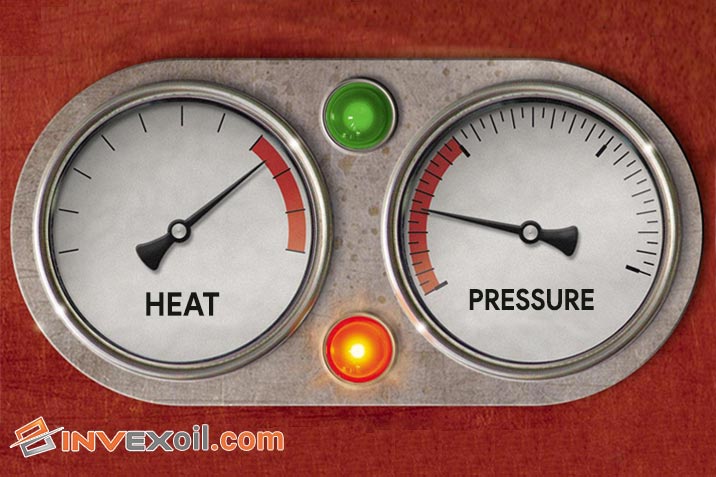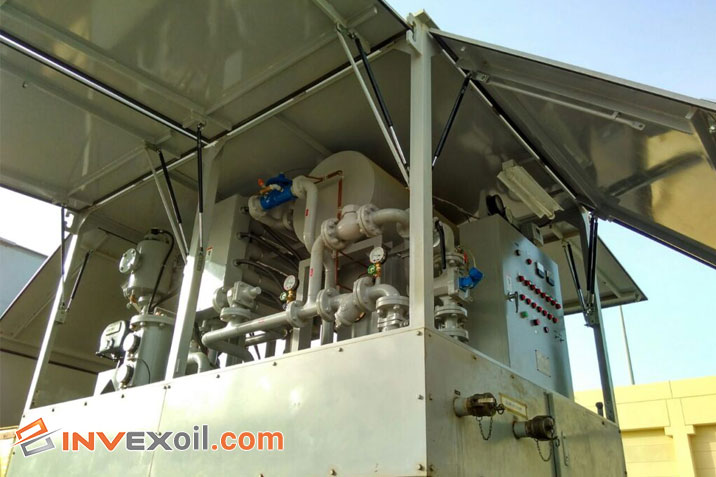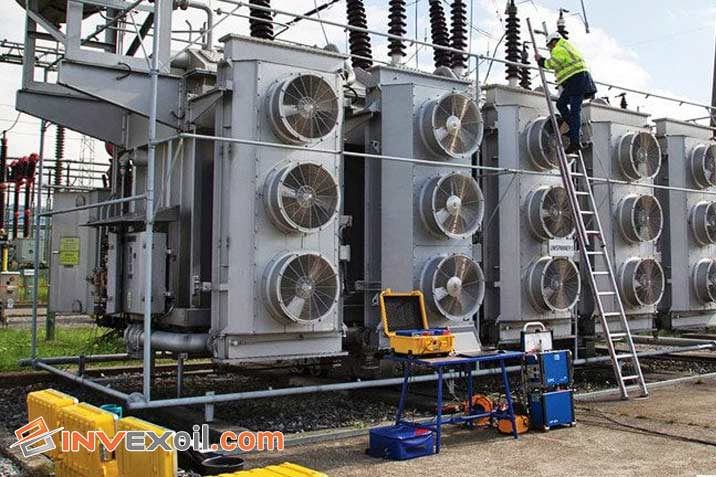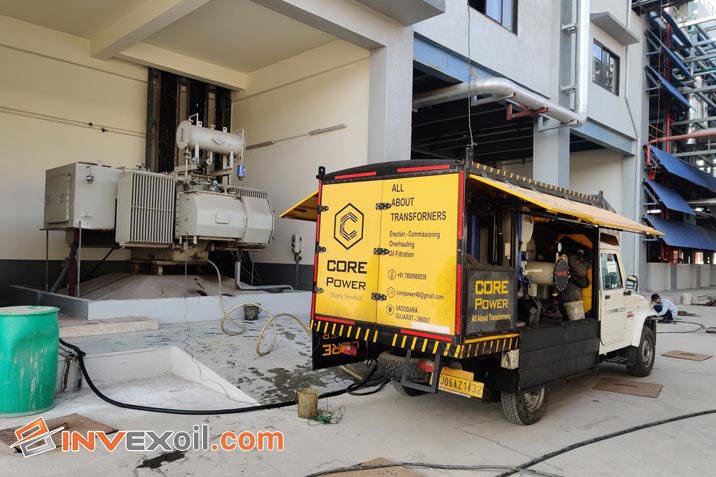Transformer oil, a vital component in electrical systems, serves the critical functions of insulation and cooling for power distribution transformers, high-voltage capacitors, switches, and circuit breakers. Understanding the factors contributing to the ageing of Transformer Oil is crucial. In brief, the ageing of Transformer Oil occurs due to various factors, including moisture penetration, high temperatures, oxidation, the presence of impurities, and inadequate maintenance.
without the presence of a Transformer oil regeneration system These elements can compromise the oil’s insulating properties, ultimately affecting the performance and longevity of transformers. In this article, we delve deeper into these factors, shedding light on their impact and importance in the world of electrical engineering.
Table of Contents
Functions and Performance of Transformer Oil
Transformer oil plays a crucial role in electrical systems, serving two primary functions: insulation and cooling. Its performance directly impacts the reliability and longevity of transformers. Here’s a closer look at these functions and performance factors:
Transformer oil’s key functions include:
- Electrical Insulation: It prevents electrical breakdown by insulating the core and windings of the transformer, maintaining a safe separation between conductive parts.
- Heat Dissipation: Transformer oil aids in dissipating heat generated during operation, ensuring that the transformer operates within safe temperature limits.
- Arc Quenching: In the event of a fault, the oil helps quench electrical arcs, preventing catastrophic failures.
- Corrosion Protection: It inhibits corrosion of transformer components, preserving their integrity.
The performance of transformer oil depends on several critical factors:
- Dielectric Strength: This measures the oil’s ability to withstand electrical stress without breaking down. High dielectric strength is essential for effective insulation.
- Viscosity: Viscosity affects the oil’s flow and heat dissipation properties. Proper viscosity ensures efficient cooling.
- Chemical Stability: Transformer oil must remain chemically stable over time to avoid unwanted reactions that could degrade its performance.
- Low Moisture Content: Excess moisture can reduce dielectric strength and accelerate aging.
- Low Acid Content: High acidity can corrode transformer components and reduce the oil’s insulating properties.
Transformer oil’s performance directly impacts the reliability and safety of electrical systems. Ensuring that it meets specified standards is essential for the smooth operation of transformers.
What is the Effect of Oil on a Transformer?
In this section, we will explore the various factors that can impact transformer oil and, consequently, the transformer itself. Each factor can lead to specific performance issues, affecting the Ageing of Transformer Oil:
| Factor | Description |
| Moisture Infiltration | Moisture can enter the oil through various ways, such as through leaks in the transformer tank, condensation, or the absorption of moisture from the surrounding air. Once moisture is present in the oil, it can accelerate the aging process by promoting oxidation and corrosion. |
| Extreme Temperatures | High temperatures can cause the oil to break down, while low temperatures can make it more viscous and less effective at cooling the transformer. Both of these conditions can lead to the aging of the oil. |
| Oxidation | Oxidation is a chemical reaction that occurs when the oil is exposed to oxygen. This reaction can produce harmful byproducts, such as acids and sludge, which can damage the oil and the transformer. |
| Impurities | Impurities, such as dirt, dust, and metal particles, can be introduced into the oil during manufacturing, installation, or maintenance. These impurities can accelerate the aging process by promoting oxidation and corrosion. |
| Inadequate Maintenance | Insufficient oil sampling and testing, as well as improper maintenance procedures, can lead to the degradation of the oil and the premature failure of the transformer. |
1-Ambient Temperature Changes
Temperature fluctuations significantly affect transformer oil. Extremes in temperature, whether hot or cold, can lead to problems such as:
- Reduced viscosity in high temperatures, potentially causing insufficient cooling.
- Increased viscosity in cold temperatures, affecting heat dissipation.
- Thermal stress on the transformer’s core and windings, potentially leading to insulation breakdown.
2-System Load and Voltage Levels Used
The load and voltage levels applied to a transformer play a crucial role in its aging. High loads and voltage stress can result in:
- Increased heat generation within the transformer.
- Accelerated aging of insulation and oil.
- Reduced overall lifespan of the transformer.
3-Pollution and Existing Impurities
Pollution and impurities in transformer oil can lead to various issues, including:
- Reduced dielectric strength.
- Increased acidity.
- Formation of sludge and sediment.
- Accelerated degradation of insulation.
4-The Possibility of the Presence of Air and its Penetration into the Oil
Air presence in transformer oil can have detrimental effects:
- Reduced dielectric strength.
- Increased risk of arcing and corona discharge.
- Accelerated aging due to oxidation.
Inadequate sealing or maintenance practices can allow air to infiltrate the oil.
5-Transformer Installation Space and Location
The environment in which a transformer is installed matters. Factors like:
- Proximity to pollutants.
- Temperature extremes in the installation area.
- Ventilation and humidity levels.
6-Operation and Maintenance
Operational practices and maintenance routines are critical for extending transformer oil life. Factors include:
- Regular oil testing and analysis.
- Prompt replacement of degraded oil.
- Maintaining proper oil levels.
- Ensuring the transformer operates within specified limits.
Maintenance Practices are here in this table.
| – | Maintenance Practice | Impact on Transformer Oil Aging |
| 1 | Regular Oil Testing and Analysis | – Early detection of issues, prolongs oil life |
| 2 | Prompt Replacement of Degraded Oil | – Prevents deterioration of oil quality |
| 3 | Proper Oil Level Maintenance | – Ensures effective cooling |
| 4 | Adherence to Operating Limits | – Prevents excessive stress on oil |
Ageing of Transformer Oil
Transformer oil, an essential component in electrical systems, can experience aging over time due to various factors. Understanding these factors is crucial for maintaining the reliability of transformers. In this section, we’ll explore the key elements contributing to the Ageing of Transformer Oil.
-
Moisture Penetration
Moisture penetration is a significant factor in the Ageing of Transformer Oil. When moisture enters the oil, it can lead to several issues:
- Reduced Dielectric Strength: Moisture contamination can lower the oil’s dielectric strength, making it less effective at insulating electrical components.
- Accelerated Oxidation: Moisture can initiate oxidation reactions within the oil, further degrading its quality.
- Increased Acidity: Water can lead to increased acidity in the oil, which can corrode transformer components.
-
High and Extreme Temperature
Temperature extremes play a crucial role in accelerating the aging process of transformer oil. Here’s how high and extreme temperatures affect the oil:
- Viscosity Changes: High temperatures can reduce the oil’s viscosity, impacting its ability to cool the transformer effectively. Conversely, extreme cold can increase viscosity, hindering heat dissipation.
- Thermal Stress: Wide temperature fluctuations can subject the transformer’s core and windings to thermal stress, potentially leading to insulation breakdown.
-
Oil Oxidation and Acidification
Oxidation and acidification are chemical processes that can occur within transformer oil, contributing to its aging:
- Oxidation: Exposure to oxygen and high temperatures can lead to oil oxidation, resulting in the formation of harmful byproducts and a decrease in oil quality.
- Acidification: Oxidation can increase the acidity of the oil, which, in turn, can corrode transformer components and reduce its insulating properties.
-
Entering Suspended Particles and Impurities in the Oil
The presence of suspended particles and impurities in transformer oil can have detrimental effects on its aging:
- Reduced Dielectric Strength: Particulate contamination can reduce the oil’s dielectric strength, potentially leading to electrical breakdown.
- Sludge Formation: Impurities can contribute to the formation of sludge and sediment within the oil, further degrading its performance.
Quality Control of Transformer Oil During Operation
In this section, we will delve into the methods used to ensure the quality of transformer oil during its service and maintenance. Monitoring and conducting specific tests are essential to guarantee the oil’s effectiveness in insulating and cooling transformers. Here, we will explain seven critical tests:
| Test | Description |
| Dielectric Strength Testing | This test measures the ability of the oil to withstand electrical stress without breaking down. A high dielectric strength is essential for the oil to effectively insulate the transformer’s components. |
| Oil Acidity Testing | This test measures the acidity of the oil. High acidity levels can corrode the transformer’s components and reduce the oil’s insulating properties. |
| Insulation Loss Coefficient Testing | This test measures the ability of the oil to conduct electricity. A high insulation loss coefficient indicates that the oil is deteriorating and may need to be replaced. |
| Surface Tension Testing | This test measures the ability of the oil to wet surfaces. A high surface tension is essential for the oil to effectively cool the transformer. |
| Dissolved Gas Analysis | This test identifies the types and levels of gases dissolved in the oil. The presence of certain gases, such as hydrogen and carbon monoxide, can indicate problems with the transformer. |
| Dissolved Water Content Testing | This test measures the amount of water dissolved in the oil. Excessive water content can reduce the oil’s dielectric strength and accelerate aging. |
| Sludge and Sediment Content Testing | This test measures the amount of sludge and sediment present in the oil. These impurities can reduce the oil’s performance and accelerate aging. |
Transformer Oil Purification
In this section, we will explore the methods of transformer oil purification, crucial for extending the life and maintaining the efficiency of transformers. Transformer oil can degrade over time due to various factors, so it’s essential to understand how to purify it effectively. The purification methods include:
Physical Purification
Physical techniques play a vital role in transformer oil purification. These methods are non-destructive and can remove various contaminants, enhancing the oil’s performance. Some key physical purification techniques include:
- Filtration: The process of passing oil through various filter media to remove particulate contaminants. This helps improve the oil’s cleanliness and dielectric strength.
- Vacuum Drying: Applying vacuum conditions to remove moisture from the oil. Moisture can accelerate oil aging, making vacuum drying an effective purification method.
- Centrifugation: Using centrifugal force to separate impurities from the oil. This method is particularly useful for removing sludge and sediment.
- Heat Exchanging: Controlling the oil’s temperature to promote the separation of contaminants. Heating and cooling cycles can aid in purification.
Chemical Treatment
Chemical treatments are essential for addressing certain impurities and contaminants in transformer oil. These methods involve the use of specific chemicals to neutralize or remove unwanted substances. Some key chemical treatments include:
- Dehydration: Chemical agents are used to absorb and remove water from the oil. This prevents moisture-related issues and improves the oil’s dielectric properties.
- Acid Neutralization: Treating the oil to neutralize acidic compounds that may have formed due to oxidation. This helps maintain the oil’s pH balance.
- Oxidation Inhibition: Adding antioxidants to the oil to prevent further oxidation, which can lead to sludge formation and reduced performance.
- Contaminant Removal: Chemical treatments can target specific contaminants, such as furans and polychlorinated biphenyls (PCBs), to ensure compliance with environmental regulations.
Conclusion
In this exploration of the Ageing of Transformer Oil, we’ve uncovered the pivotal factors that lead to its deterioration. Moisture infiltration, extreme temperatures, oxidation, impurities, and inadequate maintenance all play their part in compromising the oil’s integrity. Understanding these elements is essential in ensuring the longevity and performance of transformers. To combat this aging process, rigorous quality control measures, including dielectric strength testing, monitoring acidity, assessing insulation loss coefficients, measuring surface tension, analyzing dissolved gases and water content, and evaluating sludge and sediment presence, are employed. By recognizing and addressing these factors, we can extend the lifespan of transformer oil, safeguarding the reliability of our electrical systems.
FAQ
Now, there are some most common questions about this article, and you can read them to find your answers on them:
What are the main factors contributing to the Ageing of Transformer Oil?
Transformer oil aging is primarily influenced by moisture penetration, high temperatures, oxidation, impurities, and inadequate maintenance.
How can transformer oil quality be maintained during operation?
Quality control involves tests like dielectric strength, acidity monitoring, insulation loss coefficient assessment, surface tension measurement, dissolved gas analysis, water content analysis, and sludge and sediment evaluation.
Why is understanding transformer oil aging important for electrical systems?
Recognizing the factors causing aging is crucial to ensure the reliability and performance of transformers and other electrical components, minimizing downtime and maintenance costs.

Hello, This is Matteo Hudson Copywriter from InvexOil. We are here to provide super-important content to help you learn more easily and be involved in the world of Petroleum and Chemistry. We are here to answer your questions, help you to have better services, and also find the best solution for your problems. Don’t be shy and ask your questions in the comment box or call our number. If you want to connect with me directly, you can search for my name on Linkedin.

